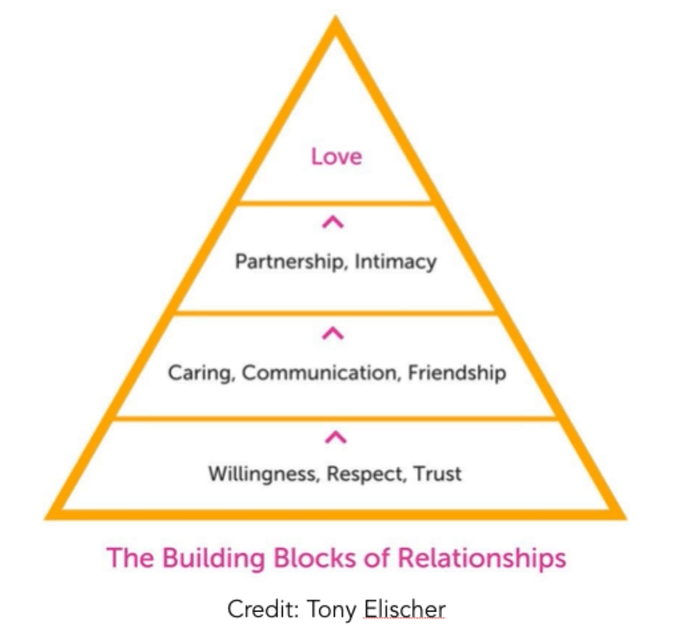
You love me. I love you. Let’s hang out and rock!
It’s doubtful you are unless you’re making robust use of your donor database for this purpose.
In other words, you must make this a TOP priority.
Retention lives or dies in how effectively, or not, you use your database to support your relationship-building, loyalty-driving efforts.
If you think of your database as a largely undifferentiated mailing list, you’re not going to realize your potential to:
- Boost renewal rates
- Increase average gift size
- Upgrade donors
- Secure major and legacy gifts
- Recapture lapsed donors
- … and more!
Really, I just can’t bear to think of you not maximizing return on your investment. And that won’t happen unless you focus on donor lifetime value. And lifetime value will be very, very small — unless you retain and upgrade donors over time.
There are 5 Keys to Donor Retention
First, find out as much as you can about your donors.
Input this information into fields in your database where it can easily be retrieved. You want to be able to sort on it for purposes of segmentation and reporting.
Second, segment your donors.
They may all be created equal, but… they’re different.
- They came to you differently
- They give different amounts of money
- They allocate gifts to different programs
- They’re affiliated with you in different ways
- They’ve been giving for different periods of time
- They live in different geographic areas
- They’re different ages
- They have different personas
Third, tailor your donor communications by segment.
The more you’re able to show donors you know them, the more warmly your communication will be received.
- Personalize acknowledgments by using (1) first names for salutations, (2) tweaked messaging that recognizes something special about the donor, and (3) inviting them to engage again in a manner that doesn’t involve more money.
- Welcome (new donor)! Would you like to attend a tour?
- Thanks for giving again (repeat donor)! Would you like to become a volunteer?
- Thanks for giving for 5 years (ongoing loyal donor)! We want to celebrate you by inviting you to an open house.
- Thanks for joining our Giving Society (upgrading donor)! Your caring means so much, and it would be an additional help if you’d be willing to give us some valuable survey feedback.
- Thanks for giving to XYZ program (earmarking donor)! Here’s a story about someone you’ve helped; feel free to share with friends who may also have an interest!
- Thanks for giving to our Facebook campaign (specific channel donor)! The goal has almost been reached; feel free to share to put us over the top, and we’ll get back to you with final results!
- Adapt reporting to speak to the purpose for which your donor gave. Don’t send a generic thank you for supporting your organization when someone really wants to hear about the specific program for which they designated their gift.
- Prioritize highest-value retention and upgrade prospects. If you can’t personalize and tailor communications for every donor, identify those where the pay-off will be the greatest. Here are segments I like to give special attention:
- First-time donors
- Donors who give higher than the average gift (calculate this using your database)
- Donors who make major gifts (this number is different for every organization)
- Donors who make multiple gifts during a year
- Donors who have been loyal over a prescribed period
Fourth, track engagement, including communications sent; use to inform your follow-up plan.
If you treat donations as one-off transactions, that’s all they’ll be. You won’t build trust, interest, engagement and investment. In fact, the Fundraising Effectiveness Project reveals charities are losing 68% of first-time donors!
But you can control this simply by prioritizing acquisition of a second gift. Once you do, you’ll see retention rates double. No kidding!
For some reason, too few nonprofits understand this. So let me say it again.
- First time donors renew at an average rate of 32%
- Second time donors renew at an average rate of 64%
Be aware that overall retention rates average 45%. This low average is likely due to the fact that nonprofits are emphasizing acquisition at the expense of retention. Of course you need new donors. Otherwise you’d have no one to retain. But if you have to choose where to spend an extra dollar, prioritize retention.
Fifth, build a donor love and loyalty plan.
This is what I like to call it, and you can grab a template here.
Others call it a retention, relationship-building, cultivation or stewardship plan. Whatever you call it, just do it!” As management guru Peter Drucker said: “The best plan is only good intentions unless it degenerates into work.”
Random acts of kindness won’t cut it. Isolated cultivation touches and moves won’t cut it. You need an intentional, integrated plan. And you must hold yourself, and others, accountable.
Use Your Database to Support Retention Efforts
Earlier this week Steven Shattuck of Bloomerang presented a webinar for the Clairification community, Making Your Donor Database Work For You. It included a strong reminder of the importance of a robust, user-friendly database to support your fundraising success. It doesn’t have to be the fanciest, most expensive software on the planet. But it should be more than an Excel spreadsheet. You want it to do more than just one thing. You don’t want a passive bucket of names you organize into segments based only on how much people give.
Steven shared a model way of thinking about engagement called the “Building Blocks of Relationships” by Tony Elischer. It’s a new ‘Donor Pyramid’ that’s about connections and affiliations, not cash.
To improve donor retention rates, your goal is to move people up the Building Relationships pyramid to the place of “LOVE.”
- Prompt, personal donor acknowledgements build trust and respect.
- Reporting builds communication, caring and friendship.
- Continuous, relevant communication builds a sense of connection and community.
- Ultimately, donors become so identified with your mission, vision and values their feelings are akin to love.
Donor Retention 101 To Do’s
- Rock the 5 keys.
- Use your database to support your strategies.
- Consider the building blocks of relationships in developing your strategies
- Create a written plan
- Hold yourself accountable
- Evaluate results
Want to Really Rock Donor Retention?
 Grab my Donor Retention and Gratitude Playbook. You’ll enter into an easy, step-by-step, six-volume journey where you’ll learn how to make a great first impression — and then a terrific second, third and fourth impression — by thanking, praising and engaging with your donors in a manner that makes them want to stay loyal to you.
Grab my Donor Retention and Gratitude Playbook. You’ll enter into an easy, step-by-step, six-volume journey where you’ll learn how to make a great first impression — and then a terrific second, third and fourth impression — by thanking, praising and engaging with your donors in a manner that makes them want to stay loyal to you.
All Clairification products come with a 30-day, no-questions-asked, 100% refund guarantee. You can’t lose!







Hi Claire, just getting to know your blog and loving your articles!
In my experience, the hardest part in the plan you lay out is managing the complexity. Your principles are impeccable but managing the people, processes, and technology involved in making a plan like this happen consistently over time (especially when you reach a certain volume) can be overwhelming for many shops.
Any thoughts on how to best achieve this?
You’re correct. As it is said, the devil is in the details. That’s why you need a plan. One into which everyone buys in. One you put in writing. One folks are held accountable to.
Begin by bringing together everyone involved in making retention happen. Talk about your current results. Consider how you might strive to improve them. Assure everyone understands the power of retention, and how it can help them achieve their goals more easily than other strategies.
Maybe even consider doing a SWOT analysis to determine what you’re currently doing well, where you’re weak, what opportunities for improvement lie on the horizon (e.g., maybe you just hired a new staff person or got a new database) and where threats lie (e.g., you just lost a staff person; there are other issues in the news that might cause your constituents to give elsewhere). If it appears you need to break your analysis into smaller components (e.g., marketing team; fundraising team; IT team), do that.
Next, turn your analyses into strategy. Create measurable objectives. Put deadlines and assignments in writing. Share with everyone. Include relevant components in staff job descriptions. Celebrate successes!